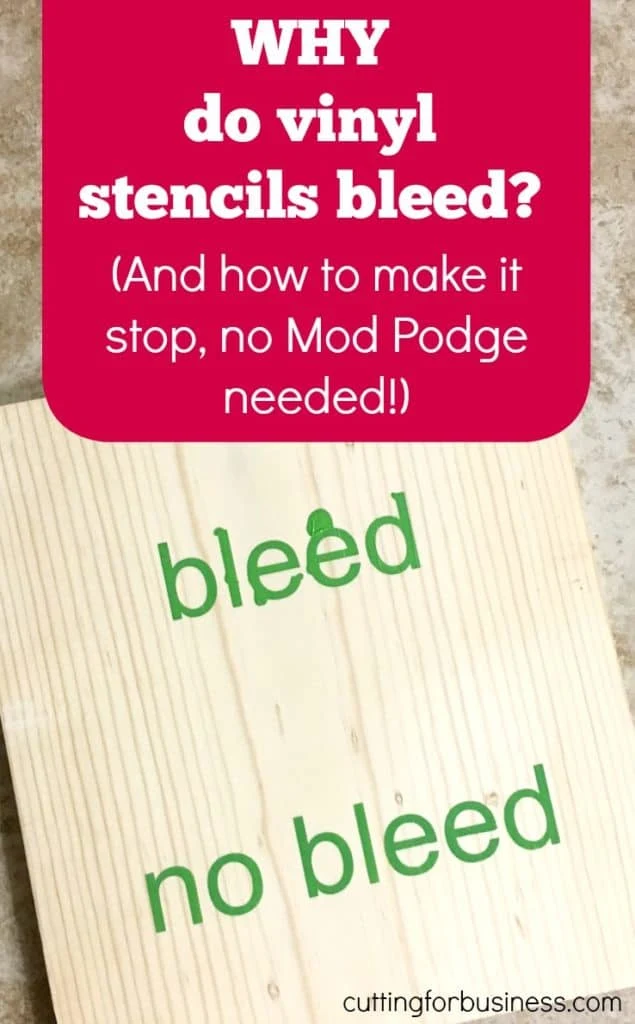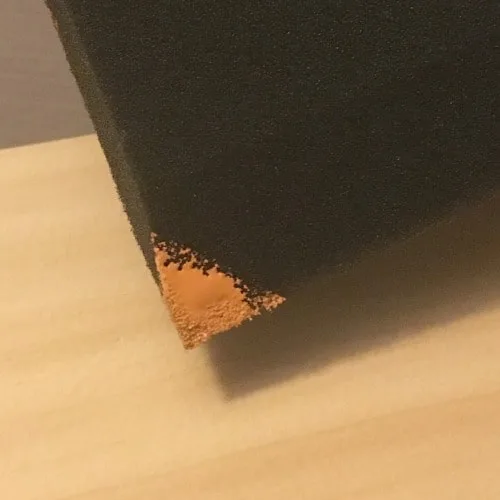Affiliate Disclosure: As an Amazon Associate I earn from qualifying purchases. Additionally, I may get commissions for purchases made through other affiliate links in this post.
If you want to sell wooden signs, they need to look nearly perfect because the market is competitive. I often see wooden sign makers struggling to get crisp paint lines when using a vinyl stencil cut on a Silhouette Cameo or Cricut. When they ask for help from fellow crafters, someone always tells them to use Mod Podge. I love Mod Podge, but it is expensive – and unnecessary when making wooden signs.
Why does paint bleed when using a vinyl stencil?
There’s actually a couple of reasons:
- The paint seeps underneath the vinyl stencil because the wood was not sanded well enough. This is probably the biggest problem I see. You should sand your wood with multiple grits of sandpaper, starting with 120 or 150 grit sandpaper and finishing with 220. When the wood is not sanded well enough, the vinyl cannot get a good seal because the surface is uneven (even if you can’t see the uneven spots). Read more about sanding wood in this post.
- The vinyl was not burnished (rubbed) well enough onto the wood. Again, the paint seeps underneath the stencil. Use a squeegee to be sure that the vinyl adheres well to the wood.
- You are using too much paint. I recommend using a foam sponge brush or a makeup sponge and dabbing the paint on in an up and down motion. It is best to only dip the corner of your brush/sponge into the paint and use a tiny amount of paint. Here’s a photo of what my brush looks like when I stencil – I use a tiny amount of paint at once:

Tip: If you try the 3 things above and are still having paint bleed, try this: After placing your vinyl stencil on the wood, paint over it using the same color as you used on the background. This seals the edges the same way that Mod Podge does – for much cheaper.
When I do recommend using Mod Podge
There is one time when I would use Mod Podge: if you are not painting the background of the sign (leaving it natural wood) AND purposely leaving the wooden surface rough. Mod Podge will help keep your paint from bleeding due to the rough surface. See the tutorial for using a stencil on rough wood at this link.
Looking for more tips about buying wood for your Silhouette Cameo or Cricut business? Head to this post. Have a ton of Mod Podge you need to use now? Check out Mod Podge Rocks for lots of craft projects.
Be sure to pin the image below on Pinterest so you can try these tips later:

Since 2015, Christine Schinagl has been helping crafters start and run craft businesses through her blog, Cutting for Business. As a Silhouette and Cricut crafter herself, she has a unique take on what works and what doesn’t work in the craft business world. She also enjoys teaching other crafters how to create digital SVG designs, available at through the Design with Me series.


Norma
Saturday 13th of October 2018
Hello. I will be painting the fabric cornices on our RV windows. I plan on painting them brown, then blue using a stencil. I am afraid it will bleed as well. Have you ever done this on fabric? Do you have any suggestions to help make this project a success? Your help is greatly appreciated :)
Christine
Tuesday 16th of October 2018
I don't usually stencil on fabric, but using tiny amounts of paint and thin layers should prevent bleeding.
Jennifer
Tuesday 27th of February 2018
I'm sure someone suggested it already, but I always use a light spray adhesive first on my stencil. Something with low tact that wont pull off the base layer
Christine
Saturday 5th of May 2018
Thanks for sharing!
Keith Whitfield
Saturday 30th of December 2017
I have been in the sign business for over 35 years. There are just some things vinyl cannot do and that is where real lettering --actual sign painting skills come into play. I have yet to find a substrate I couldn't letter with a brush and 1-Shot lettering enamel. There's no substitute or shortcut for old-time craftsmanship.
Christine
Thursday 4th of January 2018
Thanks for sharing!
Brent
Saturday 23rd of December 2017
Hello. We use Oracal 631 promotional cal vinyl. I've wondered about trying some different types like 341 and oramask 813? What do you recommend?
Christine
Sunday 24th of December 2017
I use and recommend 813.
Sarah N
Wednesday 20th of December 2017
Hi! I was wondering if you had any tips for me...I’m not having issues with the paint bleeding so much, but I am having issues with the paint peeling up off of the wood when I’m taking the vinyl off. What kind of paint to use?? Any idea what I might be doing wrong?? I’ve tried waiting until it was fully dry, I’ve tried taking it off when it is mostly dry, modge podge and no modge podge and it’s peeled with all of them (some worse than others. One more question, I’ve had a hard time getting my vinyl to stick to the wood, it doesn’t come off my transfer paper very easily. Any thoughts!
Christine
Thursday 21st of December 2017
Hi Sarah, If your background is pulling up, see this post: https://cuttingforbusiness.com/2017/12/11/wood-signs-how-to-prevent-your-vinyl-stencil-from-peeling-your-paint-up/. If you are having a hard time with getting the vinyl to stick to the wood, your problem is sanding. Head to this post: https://cuttingforbusiness.com/2017/10/19/how-to-sand-wood-painted-signs/.